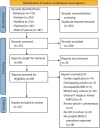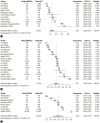Global prevalence of metabolic dysfunction-associated fatty liver disease-related hepatocellular carcinoma: A systematic review and meta-analysis
- PMID: 38623613
- PMCID: PMC11261220
- DOI: 10.3350/cmh.2024.0109
Global prevalence of metabolic dysfunction-associated fatty liver disease-related hepatocellular carcinoma: A systematic review and meta-analysis
Abstract
Background/aims: The global proportion of hepatocellular carcinoma (HCC) attributable to metabolic dysfunction-associated fatty liver disease (MAFLD) is unclear. The MAFLD diagnostic criteria allows objective diagnosis in the presence of steatosis plus defined markers of metabolic dysfunction, irrespective of concurrent liver disease. We aimed to determine the total global prevalence of MAFLD in HCC cohorts (total-MAFLD), including the proportion with MAFLD as their sole liver disease (single-MAFLD), and the proportion of those with concurrent liver disease where MAFLD was a contributary factor (mixed-MAFLD).
Methods: This systematic review and meta-analysis included studies systematically ascertaining MAFLD in HCC cohorts, defined using international expert panel criteria including ethnicity-specific BMI cut-offs. A comparison of clinical and tumour characteristics was performed between single-MAFLD, mixed-MAFLD, and non-MAFLD HCC.
Results: 22 studies (56,565 individuals with HCC) were included. Total and single-MAFLD HCC prevalence was 48.7% (95% confidence interval [CI] 34.5-63.0%) and 12.4% (95% CI 8.3-17.3%), respectively. In HCC due to chronic hepatitis B, C, and alcohol-related liver disease, mixed-MAFLD prevalence was 40.0% (95% CI 30.2-50.3%), 54.1% (95% CI 40.4-67.6%) and 64.3% (95% CI 52.7-75.0%), respectively. Mixed-MAFLD HCC had significantly higher likelihood of cirrhosis and lower likelihood of metastatic spread compared to single-MAFLD HCC, and a higher platelet count and lower likelihood of macrovascular invasion compared to non-MAFLD HCC.
Conclusion: MAFLD is common as a sole aetiology, but more so as a co-factor in mixed-aetiology HCC, supporting the use of positive diagnostic criteria.
Keywords: Epidemiology; Fatty liver; Hepatocellular carcinoma; Metabolic syndrome; Prevalence.
Conflict of interest statement
JG is on Advisory Boards and has received honoraria for talks from Novo Nordisk, Astra Zeneca, Roche, BMS, Pfizer, Cincera, Pharmaxis, Boehringer Mannheim.
Figures



Comment in
-
Metabolic dysfunction-associated fatty liver disease is a ubiquitous latent cofactor in viral- and alcoholic-related hepatocellular carcinoma: Editorial on "Global prevalence of metabolic dysfunction-associated fatty liver disease-related hepatocellular carcinoma: A systematic review and meta-analysis".Clin Mol Hepatol. 2024 Oct;30(4):705-708. doi: 10.3350/cmh.2024.0372. Epub 2024 May 20. Clin Mol Hepatol. 2024. PMID: 38768960 Free PMC article. No abstract available.
References
-
- Eslam M, Newsome PN, Sarin SK, Anstee QM, Targher G, Romero-Gomez M, et al. A new definition for metabolic dysfunction-associated fatty liver disease: An international expert consensus statement. J Hepatol. 2020;73:202–209. - PubMed
-
- Eslam M, Sanyal AJ, George J, International Consensus Panel MAFLD: A consensus-driven proposed nomenclature for metabolic associated fatty liver disease. Gastroenterology. 2020;158:1999–2014.e1. - PubMed
Publication types
MeSH terms
Grants and funding
LinkOut - more resources
Full Text Sources
Medical

